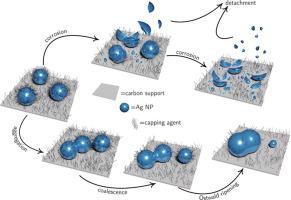Journal of Catalysis ( IF 7.3 ) Pub Date : 2021-10-21 , DOI: 10.1016/j.jcat.2021.10.016 Menglong Liu 1, 2 , Ying Kong 1, 2 , Huifang Hu 1 , Noémi Kovács 1 , Changzhe Sun 1, 2 , Iván Zelocualtecatl Montiel 1 , María de Jesús Gálvez Vázquez 1 , Yuhui Hou 1 , Marta Mirolo 3 , Isaac Martens 3 , Jakub Drnec 3 , Soma Vesztergom 1, 4 , Peter Broekmann 1, 2

|
We apply silver nanoparticles (Ag NPs) as catalysts of CO2 reduction in a zero-gap gas-flow electrolyser. Ag NPs stabilized by different ligands —branched polyethylenimine (BPEI), polyvinylpyrrolidone (PVP), polyethylene glycol (PEG), and citrate— are used in the experiments. The as-prepared NPs have almost identical initial size distributions, yet their catalytic performance, in terms of achievable current and CO selectivity, is different. During electrolysis all Ag NPs exhibit unambiguous morphology changes; the degradation pathway they follow, however, markedly depends on the chemical nature of the capping agent stabilizing them. Scanning electron micrographs obtained before and after constant-charge electrolyses carried out at different potentials reveal that amongst the studied ligands, BPEI seems to be the most effective stabilizer of Ag NPs; in turn, however, BPEI also limits CO formation the most. In case of PVP, mostly corrosion (particle shrinkage) is observed at practically relevant electrolysing potentials, while the application of PEG leads more to particle coalescence. Ostwald ripening seems to appear only at high applied (H2 forming) potentials in case of the three afore-mentioned ligands while in case of citrate it becomes significant already at mild (CO forming) voltages. By studying the effects of capping agent removal and exchange we demonstrate that apart from ligands directly attached to the Ag NPs, also the excess of capping agents (adsorbed on the electrode surface) plays a decisive role in determining the extent and mode of catalyst degradation. The results of SEM-based particle sizing are also confirmed by synchrotron based wide-angle X-ray scattering measurements that provide further insight into the evolution of crystallite size and lattice strain in the applied Ag NPs during electrolysis.
中文翻译:

封端剂是关键:在零间隙气流配置中探测 CO2 电解过程中 Ag NPs 的结构变化
我们应用银纳米粒子 (Ag NPs) 作为 CO 2 的催化剂减少零间隙气流电解槽。实验中使用了由不同配体(支化聚乙烯亚胺 (BPEI)、聚乙烯吡咯烷酮 (PVP)、聚乙二醇 (PEG) 和柠檬酸盐)稳定的 Ag NP。所制备的 NPs 具有几乎相同的初始尺寸分布,但它们的催化性能(在可实现的电流和 CO 选择性方面)是不同的。在电解过程中,所有的银纳米颗粒都表现出明确的形态变化;然而,它们所遵循的降解途径明显取决于稳定它们的封端剂的化学性质。在不同电位下进行恒电荷电解前后获得的扫描电子显微照片表明,在所研究的配体中,BPEI 似乎是 Ag NPs 最有效的稳定剂;然而,反过来,BPEI 也最大程度地限制了 CO 的形成。在 PVP 的情况下,主要是在实际相关的电解电位下观察到腐蚀(颗粒收缩),而 PEG 的应用导致更多的颗粒聚结。奥斯特瓦尔德熟化似乎只出现在高施肥(H2形成)电位在上述三种配体的情况下,而在柠檬酸盐的情况下,它在温和(CO 形成)电压下已经变得显着。通过研究封端剂去除和交换的影响,我们证明除了直接连接到 Ag NPs 的配体外,过量的封端剂(吸附在电极表面)在确定催化剂降解的程度和模式方面也起着决定性的作用。基于 SEM 的粒度测量结果也得到了基于同步加速器的广角 X 射线散射测量的证实,这些测量提供了对电解过程中应用的 Ag NP 中微晶尺寸和晶格应变演变的进一步了解。


























 京公网安备 11010802027423号
京公网安备 11010802027423号